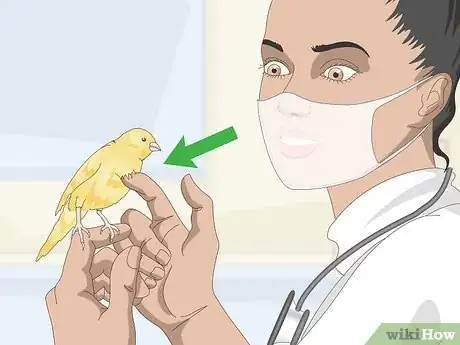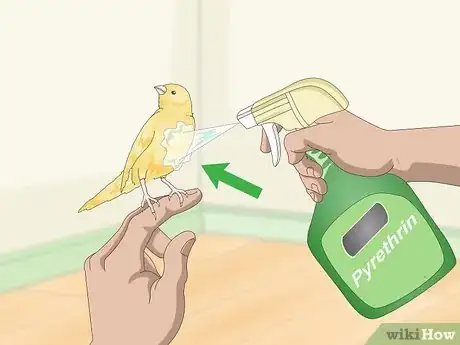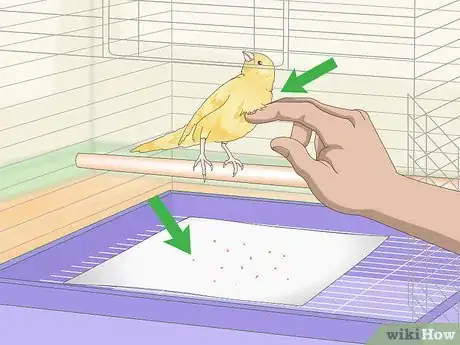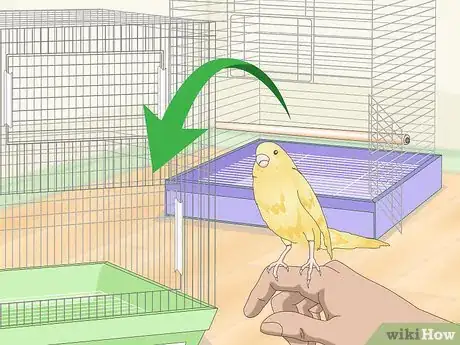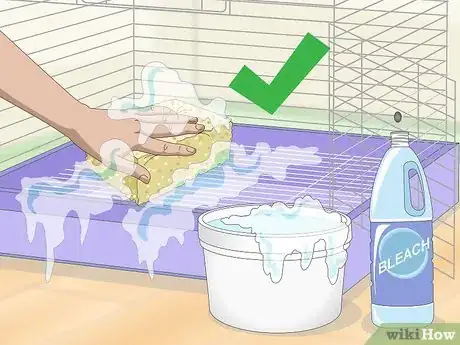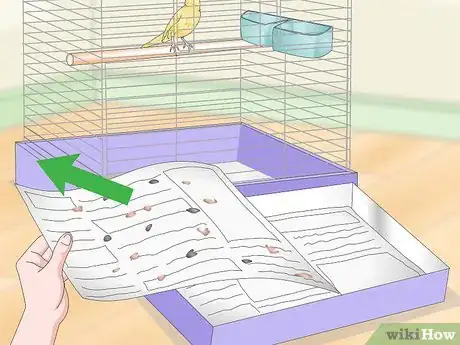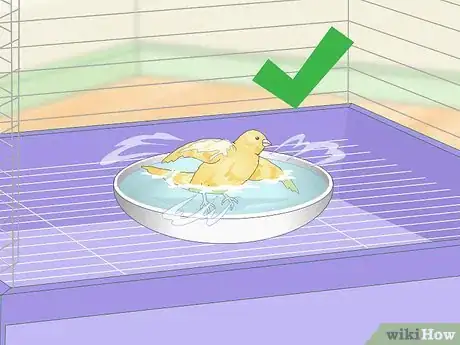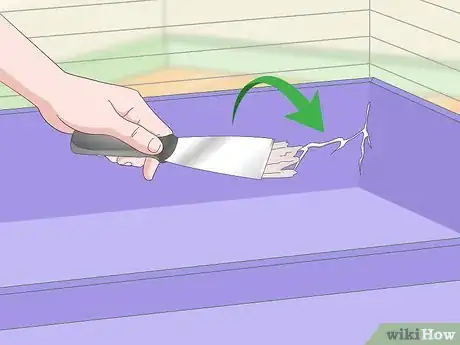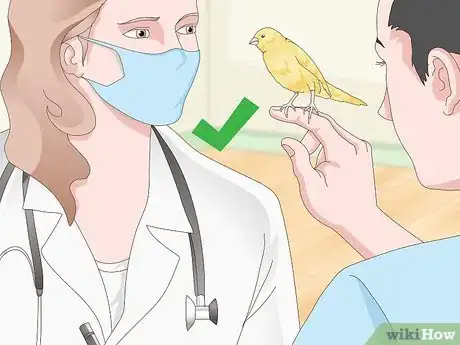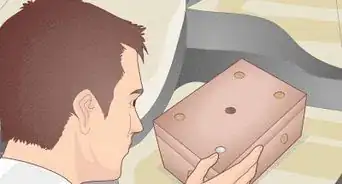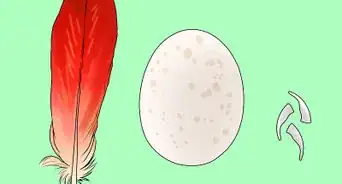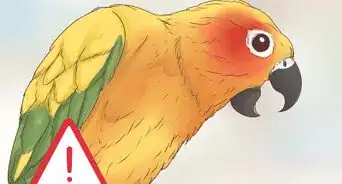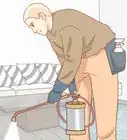This article was co-authored by Pippa Elliott, MRCVS. Dr. Elliott, BVMS, MRCVS is a veterinarian with over 30 years of experience in veterinary surgery and companion animal practice. She graduated from the University of Glasgow in 1987 with a degree in veterinary medicine and surgery. She has worked at the same animal clinic in her hometown for over 20 years.
wikiHow marks an article as reader-approved once it receives enough positive feedback. In this case, 98% of readers who voted found the article helpful, earning it our reader-approved status.
This article has been viewed 31,837 times.
Canaries can be wonderful pets, but they do require some work to keep happy and healthy. One thing you need to do to keep canaries healthy is to make sure that they are free of parasitic infections, such as lice and mites. If you suspect that your canaries have mites or lice, you need to get them veterinary care, and you need to sterilize their cage. With treatment of both the birds and their cages, you can eliminate these nasty infections.
Steps
Getting Veterinary Treatment for Lice and Mites
-
1Take your canary to a veterinarian. If you suspect that your canary has a mite or lice infection, you should take it to be seen by a veterinarian. A veterinarian will be able to assess the situation, give you a definitive diagnosis, and lay out a plan for treatment.[1]
- Lice and mite infections can be very uncomfortable for a canary, so you should have it seen by a veterinarian at the vet's next available appointment.
-
2Apply a bird-safe insecticide to your canary. Once your veterinarian has established what type of infection your canary has, they will suggest an insecticide to give to the bird. In some cases, such as a lice infection, the bird will be given a broad spectrum antiparasitic, such as carbaryl dust, pyrethrin spray, or ivermectin. Follow your veterinarian's advice about how to give your bird this medication, including how much and how often to apply them.[2]
- For instance, you may need to give a measured amount of a 1% solution of ivermectin to your bird at 10 days, 20 days, and 30 days after the vet visit.
Advertisement -
3Watch your canary for signs of continued infection. Once you have begun treatment, you should keep an eye on your bird for signs of recovery. Depending on whether your bird has a mite or lice infection, these signs will differ.
- If your bird has a blood mite infection, put a clean white paper towel in the bottom of your bird's cage every morning. As it recovers, you should see fewer and fewer red dots covering the bottom of the cage.
- If your bird has lice, you will need to inspect the bird's body on a regular basis to ensure that the lice have been eliminated. Look under the bird's wings and all around its body for lice or lice eggs.
Eliminating Lice and Mites from a Bird Cage
-
1Move your canary to a clean cage. Once you have started treating the bird itself, you will also need to clean its cage. Move your canary to a different cage, so that you can clean its permanent cage from top to bottom.
- Typically, you should take your bird to the vet in a smaller cage, and you can keep it in that smaller cage temporarily while you clean the bigger cage.
-
2Sterilize the bird's infected cage and all supplies. Take the bird's cage apart and clean each individual piece. This includes not only the parts of the cage but all supplies inside. Cleaning your bird's food dishes, water dish, perches, and toys will help to eliminate the infection.[3]
- Scrub everything with hot soapy water. Then everything should be rinsed with a mixture of one part bleach to ten parts water.[4]
- Once you are finished cleaning your canary cage and supplies, allow them to dry before putting the cage back together.
- If you have a hard time cleaning certain items, such as toys with lots of nooks and crannies, consider throwing them out. Replacing them is a better idea than risking reinfection because they can't be cleaned properly.
-
3Place insecticide in the cage. If you are having a persistent problem with mites or lice, you may want to apply an insecticide to the bottom of your bird's cage or to your bird's water. Over-the-counter insecticides, such as Sevin Dust, can keep parasites from surviving at the bottom of your canary cage when it is applied to the cage floor. You can place other products in your bird's water, such as Avian Insect Liquidation, which keep parasites at bay when the bird ingests them.
- Products such as Sevin Dust are typically available at your local garden center.
- Avian Insect Liquidation can be supplied by your veterinarian.
Preventing Parasitic Infections
-
1Keep your bird's cage clean. Cleaning your bird's cage regularly is central to keeping your birds parasite free. It removes their waste, excess food, and any other germs and bacteria that accumulates on the bird's supplies.[5]
- Take the time to do light cleaning every day, such as changing the paper at the bottom of your bird's cage. However, be sure to do a thorough cleaning of the cage, top to bottom, every week.
- You should regularly sterilize your bird's cage, perches, toys, food dishes, water dish, and nesting areas.
-
2Give your bird the ability to bathe. In addition to cleaning your bird's cage, you should allow it to clean itself. Place a shallow dish of warm water at the bottom of your bird's cage every day.[6] You can also provide a dish of Diatomaceous earth for your bird to bathe in to help eliminate lice and mites.
- If your canary doesn't jump on the chance to clean off in a shallow dish of water, consider misting it with warm water. Some birds just prefer this method of bathing.
-
3Eliminate areas in the cage where parasites can live. There are some parasites, such as blood mites, that can live in the cracks of cages and feed on your birds at night. In order to eliminate these parasites, you will need to fill any gaps or cracks that they can live in.
- Fill in little cracks and gaps with spackle and then paint the area with bird-safe paint.
-
4Get your bird regular veterinary care. Some parasites are difficult for owners to spot, so your veterinarian may be key in identifying an infection early on. If you get your bird regular veterinary care, the vet will be able to spot the infection before it compromises your bird's health completely.
- If you bring your canary in for an annual exam your veterinarian will do an overall health assessment in order to spot the signs of infection.
References
- ↑ http://www.exoticpetvet.net/avian/mites.html
- ↑ http://www.exoticpetvet.net/avian/mites.html
- ↑ https://www.beautyofbirds.com/featherlice.html
- ↑ https://vet.purdue.edu/vth/files/documents/general%20husbandry%20of%20caged%20birds.pdf
- ↑ https://www.beautyofbirds.com/featherlice.html
- ↑ https://www.beautyofbirds.com/featherlice.html
About This Article
To treat lice and mites in your canary, take it to your vet right away for a proper diagnosis and treatment plan. Your vet will likely recommend an insecticide and a broad spectrum antiparasitic to treat the underlying infection. Once your canary begins treatment, keep an eye out for signs of recovery, like fewer lice or lice eggs, or less red dots from blood mites. Additionally, sterilize your canary’s cage and supplies by washing everything in hot, soapy water and rinsing it with a mixture of 1 part bleach to 10 parts water. For more tips from our Veterinary co-author, including how to prevent parasitic infections in your canary, keep reading!
